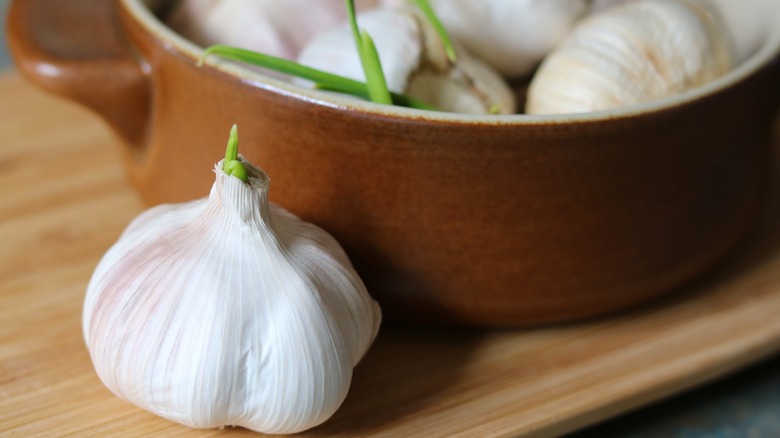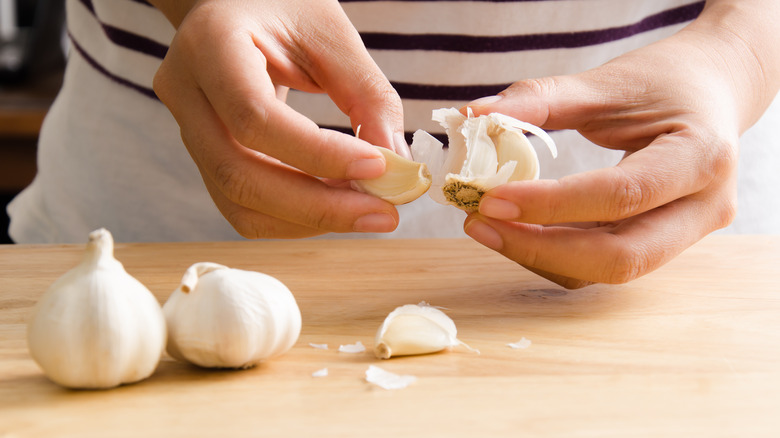What The Heck Is A Garlic Germ (And Is It Edible)?
There's no denying the potent flavor of garlic, especially when you're using the ingredient in its raw form. In this case, you'll need to break down the garlic clove before it can be added to dishes like pasta, roasted potatoes, and baked chicken. Regardless of which one of the many garlic peeling methods you use to prep the ingredient, you may be surprised to find a green, sprout-like thing in the center. This is often referred to as the garlic germ, which is simply the vegetable's way of growing a new version of itself.
It's perfectly safe to eat the garlic germ but bear in mind that it can significantly affect the flavor of your garlic-infused dishes. It can even indicate that the garlic you're using is a bit past its prime, as the growth of a sprout typically occurs after garlic has been stored for an extended period. It can also develop if garlic has been subject to unfavorable storage conditions, such as high heat and humidity. When it comes to removing the germ or keeping it intact, consider that the subject is just a bit controversial, as illustrated by a Reddit thread discussing the matter. Some claim that the garlic germ "always needs to be removed," while others state that doing so is "absolutely unnecessary."
What does the garlic germ actually taste like?
The flavor of garlic depends on how it's prepared. When raw, the vegetable has a subtly spicy yet pleasing bite, while cooking it creates a milder flavor profile that's tinged with sweetness. Garlic is quite pungent regardless of the preparation, and even those who love the vegetable aren't huge fans of the impact garlic can have on their breath (which is why it's good to know the fastest way to banish garlic breath).
When it comes to the garlic germ, the pungent and potent quality of garlic is amplified and may even negatively affect the finished dish. Consider that the sprout or germ of garlic is often described as having a bitter quality. In some cases, garlic germs are said to have a powerfully spicy taste comparable to something like horseradish. In recipes, the germ may overwhelm more delicate flavors, or simply taste downright unpalatable on its own. These concerns are a big reason why some people advocate removing the germ prior to incorporating garlic into other dishes.
When to de-germ your garlic
There's a scientific reason why rinsed garlic has a milder flavor, but the age of the vegetable also plays a role in flavor intensity. As garlic ages, it experiences a depletion of moisture, which can make for a more potent flavor. Conversely, garlic tends to offer the mildest flavor immediately after it's been harvested. Also, young garlic has a much smaller germ, which lacks the potency of the germ found in older garlic heads. If you know you're using fresh garlic, meaning you're using the vegetable soon after its late spring to late summer harvest time, you can probably leave the germ intact without concerns about the flavor being too overwhelming when used in recipes.
With older garlic, the preparation dictates whether the germ should be removed. Heavily cooking garlic tempers the flavor, so it may be fine to leave the germ intact in that case. Light cooking and raw preparations typically require the removal of the germ unless you're a fan of intense bitter flavors. You can also prevent garlic from sprouting by storing the vegetable correctly in your kitchen. Garlic fares best in a dry area subject to good airflow and protected from extreme temperatures (that means no storing garlic in your fridge). If you take these steps, you'll have fewer issues with sprouting garlic cloves in your pantry.


